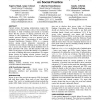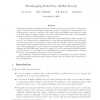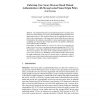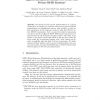151 search results - page 15 / 31 » Secure Human Identification Protocols |
CHI
2007
ACM
14 years 8 months ago
2007
ACM
Current systems for banking authentication require that customers not reveal their access codes, even to members of the family. A study of banking and security in Australia shows ...
SAC
2006
ACM
14 years 1 months ago
2006
ACM
Increasingly pervasive computing throws up scenarios where users may wish to achieve some degree of security in their interaction with other people or equipment, in contexts where...
FC
2010
Springer
13 years 11 months ago
2010
Springer
A number of security systems, from Chip-and-PIN payment cards to contactless subway and train tokens, as well as secure localization systems, are vulnerable to relay attacks. Encry...
ACISP
2008
Springer
14 years 1 months ago
2008
Springer
The standard solution for mutual authentication between human users and servers on the Internet is to execute a TLS handshake during which the server authenticates using a X.509 ce...
FC
2010
Springer
13 years 8 months ago
2010
Springer
We provide several concrete implementations of a generic method given by Vaudenay to construct secure privacy-preserving RFID authentication and identification systems. More precis...




